| Best Image Gallery |
| HOME Best Lunar Planets Deepsky Misc Equipment Techniques Links |
| This page is a gallery of my best images to date. Most link to larger images or web pages. |
30 March 2008, M81 and M82

|
In Ursa Major, near the famous Plough (or big dipper) asterism, can be found two of the brighter and visually appealing galaxies in the Messier list. M81 is known as Bode's galaxy and M82 is also called the Cigar galaxy. The pair are only two members of the M81 group, which is one of the closest galaxy groups to our own Local Group, approximately 12 million light years away.
M81 is a classic face-on spiral, and is bright enough to see with binoculars (I have done so during a total lunar eclipse!) or even with the unaided eye according to some reports. M82 is a more unusual galaxy, classed as irregular - possibly an edge-on disk. M82 has distinctive dark dust lanes that are thought to be the result of an encounter with M81. This encounter has also left an impression in M81. | ||||||
|
For this picture I captured luminance and red/green/blue on 12 March, and combined them to make this LRGB image. The image can be seen below. Then on 30 March I captured an hour of Hydrogen alpha and blended it into the red channel. This shows the red gas bursting out from M82, and some small hydrogen regions in M81. |
Image Details:
| ||||||
| to top | home | ||||||
14 November 2007: M45

|
This is an LRGB image of M45 the Seven Sisters or Pleiades, one of the most attractive open clusters in the sky, and one that is bright enough to be visible with the naked eye. For this picture I had some cotton thread across my telescope's aperture, which caused the prominent diffraction spikes to appear on the bright stars in the picture. Since the cluster contains so many bright stars, there are a lot of spikes! The Pleiades is a young cluster, and is passing by a cloud of gas which is being lit by reflection from the stars.
Details:
| ||||||
| to top | home | ||||||
| Scorpius and the Milky Way, with Jupiter, from Spain, 2007 | |||||||
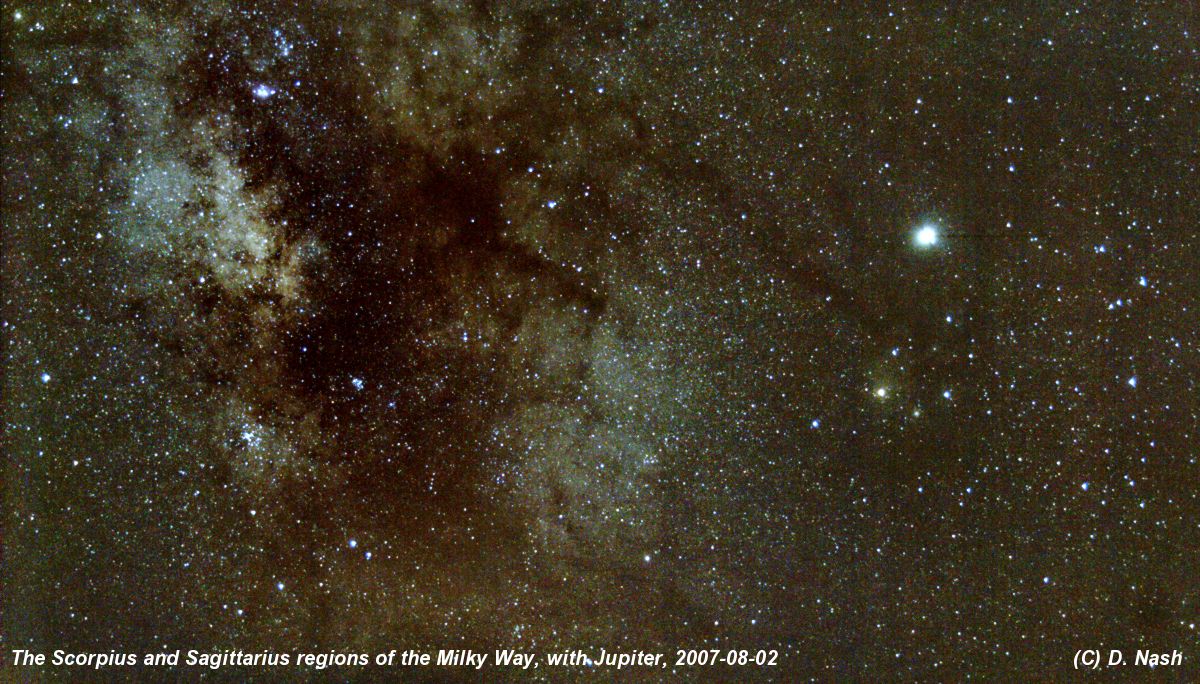
|
|||||||
|
This picture shows the constellation of Scorpius with Jupiter and the Milky Way.
Go to the Milky Way Page to see identifications of some of the objects in this image. This image is a stack of 22 30-second exposures, made using my Canon EOS 300D, set to ISO 1600. The standard kit 18-55mm lens was used, set to 33mm, f/4.5. The pictures were stacked using Deep Sky Stacker and post-processed in Pleiades PixInsight LE and The Gimp. | |||||||
| to top | |||||||
3 March 2007: Total Eclipse of the Moon

|
|||||||
|
On 3 March 2007 was a spectacular eclipse of the moon. I used my Canon EOS300D camera on a Megrez 80 Super Apo Triplet telescope to capture a photographic record of the event. Click HERE for full details and more pictures. | |||||||
| to top | home | ||||||
2 March 2007: Occultation of Saturn
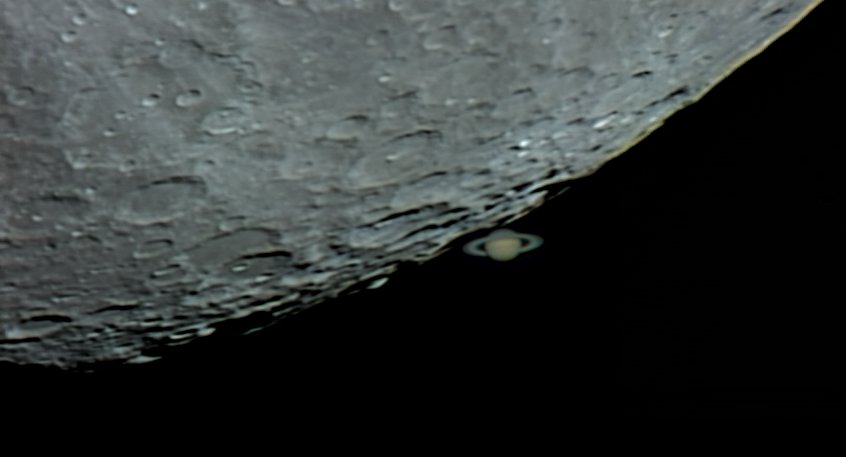
|
|||||||
| In the small hours of the 2 March 2007, the moon covered Saturn as seen from parts of Western Europe. I recorded the event using my TouCam Pro webcam on a C8 telescope. The image shown here is a composite using positional data from the actual event, and images processed separately for each object. Click the image to see more images including actual captures of the event. | |||||||
| to top | home | ||||||
11 February 2007: Venus wide field
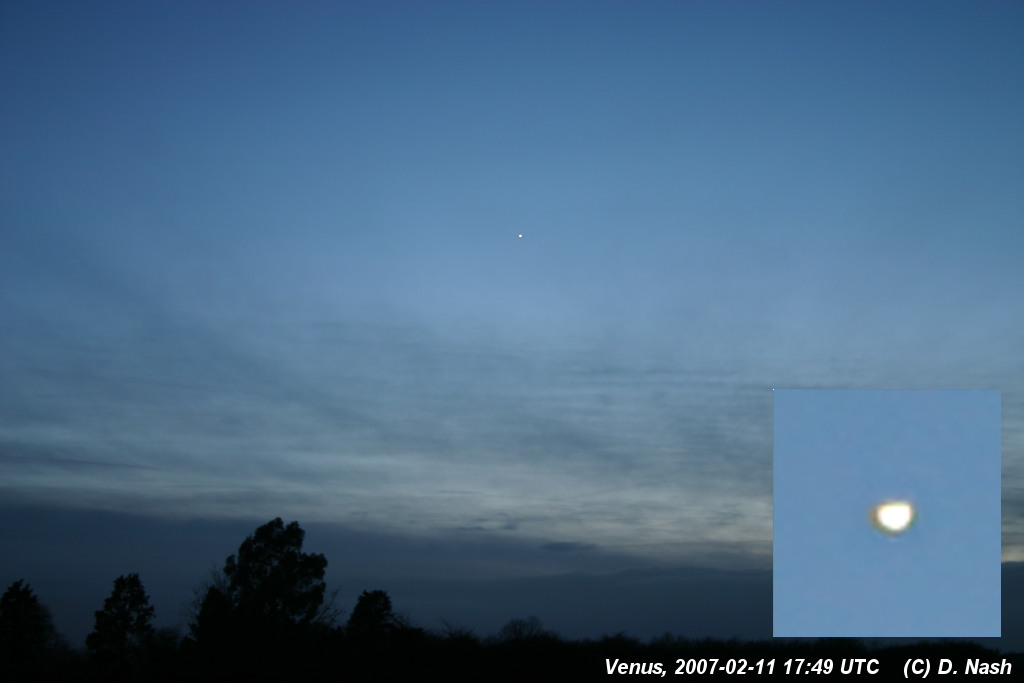
|
|||||||
|
The bright dot in the middle of this picture is Venus as the "Evening Star" in this wide-field image. The close-up shows how Venus is showing a gibbous phase just as the moon does. This is because it is between the Earth and the sun.
This image was taken using my EOS300D Digital SLR camera with its standard 55mm lens. Some colour fringing is evident around the planet, due to its low altitude -- the light is refracted by the atmosphere. However the gibbous phase is surprisingly clear even with this small lens. Click the picture for the full-sized image. | |||||||
| to top | home | ||||||
3 April 2006: M51, the Whirlpool Galaxy
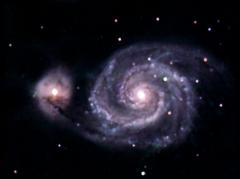
|
Using my Vesta SC3 webcam I captured luminance (black and white) data plus some colour images to give this result.
To produce this image I stacked 80x18seconds luminance, and merged in the result from 3 March, although this didn't add a lot to the final image. I also captured 50 frames each through red, green, and blue filters, to provide the colour data for the image. The R/G/B images were stacked separately in K3CCDTools then merged into one colour image using Registax 3. The RGB and the Luminance images were processed separately in PixInsight LE, and finally merged into one LRGB colour image using The Gimp. Some noise was reduced using NeatImage. Click the image to see a large (800 pixel wide) version, or click HERE to see the original 640x480 image. | ||||||
| to top | home | ||||||
25 January 2006: The Rosette Nebula and Open Cluster
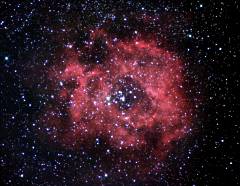
|
In the constellation of Monoceros (The Unicorn), lies this cluster and nebula. The cluster at the centre is designated NGC2244. It contains young stars forming from the gas in the nebula, which has been given catalogue numbers NGC2237, 2238, 2239, and 2246 to describe its various parts. The nebula is large, covering over one degree of arc across the sky. A young star was discovered there as recently as 2004, as described in This press release.
This image is a stack of 8x5-minute exposures. They were captured with my EOS 300D camera at prime focus of my Megrez 80 II SD telescope, with the camera set to ISO 800 and an Astronomik CLS filter was used. The frames were stacked in K3CCDTools, then post-processed using PixInsight LE and The Gimp. | ||||||
| to top | home | ||||||
23 December 2005: Horsehead and Flame Nebulae in Orion's Belt
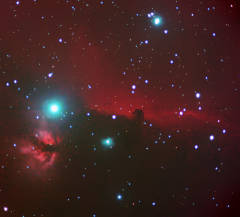
|
The constellation of Orion holds many other interesting objects in addition to the so-called Orion Nebula. One of the most well-known objects in the sky is the Horsehead Nebula, or Barnard-33. This is a dark nebula which shows up against a red background of glowing hydrogen gas. Of course it gets its name from its distinctive shape.
B-33 is located to the south of the leftmost star in the group of three known as Orion's Belt. This star is called Alnitak and is the brightest in this picture. Nearby is another nebula known by the catalogue number of NGC2024, or more frequently, by its familiar name of the Flame Nebula. This is another mixture of red glowing gas and dark lanes, and is thought by some to resemble a tree in appearance. This image is a stack of 13x5-minute exposures. They were captured with my EOS 300D camera at prime focus of my Megrez 80 II SD telescope, with the camera set to ISO 800 and an Astronomik CLS filter was used. The frames were stacked in K3CCDTools, then post-processed using PixInsight LE and The Gimp. These deep-sky-objects are fainter than the other orion nebulae pictured below, and require much more exposure time on the camera. I will capture more images of these items when possible, and combine them with the image shown here to improve the detail and reduce noise. | ||||||
| to top | home | ||||||
6 December 2005: Orion's Sword: M42, M43, NGC1977

|
This image was captured at prime focus of my Megrez 80 II SD refractor with the Canon EOS300D camera. It shows the great emission nebula M42 with the smaller comma-shaped companion M43. Also in the picture is the blue reflection nebula NGC1977, or the Running Man. Lastly, the bottom-left of this picture shows the cluster of stars that form the lower end of Orion's famous sword.
As is common with pictures of this nebula, this image is formed from a composite of long and short exposures. On this occasion I used is 4x20sec, 5x30sec, 1x1min and 1x2min all captured at ISO 800. The result shows detail in the core as well as some of the fainter outlying nebulosity. I stacked the individual same-length exposures using K3CCDTools, then combined them and post-processed in PixInsight LE. Final tweaks were done using The Gimp. This region holds much more nebulosity and glowing gas than is shown here. I will be trying to get more exposures of Orion and adding to this image in the future. | ||||||
| to top | home | ||||||
4 November 2005: NGC7000, the North America Nebula and IC5070, the Pelican Nebula

|
This picture shows a region full of glowing gas and nebulae on a backdrop of dense Milky Way star fields in the constellation of Cygnus. The two named objects are emmision nebulae. NGC7000 is a large bright nebula containing several clusters of stars. IC5070 is another, similar, nebula which although not quite so bright, is close enough to NGC7000 to be well-known, not least for its characteristic shape, for which it was named the Pelican Nebula. There are many other named and unnamed glowing areas of gas in this area, some of which are shown in this picture.
For this image, which was captured using the Canon EOS300D DSLR attached to my ST80 refractor, I used my Astronomic CLS filter for the first time. This had the effect of suppressing the background glow and allowing the light emitted by the nebulae and stars to pass. I captured 12x5-minute exposures at ISO 1600. The images were stacked using K3CCDTools and processed using PixInsight LE and The Gimp. | ||||||
| to top | home | ||||||
4 October 2005: Stephan's Quintet Galaxy Group
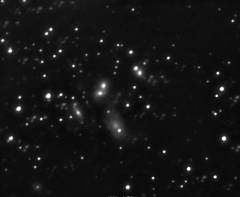
|
This cluster in the vicinity of larger galaxy NGC7331 (See below) comprises NGC7317, 7318A, 7318B, 7319, and 7320. In this picture NGC7320C is also visible to the lower left. Measurements suggest that NGC7320C is much closer than the others, and is therefore a chance foreground object, not part of the cluster.
The members of this cluster are rather small and faint, and therefore hard to see in the telescope eyepiece. However its closeness to NGC7331 means that the larger galaxy can be used as a pointer to locating the small group. This image is a stack of about 70x40 second frames, stacked in K3CCDTools. They were captured using the Vesta SC3 camera in B&W raw mode, at prime focus of my Europa 250 newtonian telescope, with a Baader UV-IR blocker. Gamma was set to 26%, and gain to 86%. About 15 frames were captured using an Astronomik CLS light-pollution filter, for which the gamma was increased to 68%. The image was processed using PixInsight LE, the Gimp 2, and Iris. |
||||||
| to top | home | ||||||
Mars, 17 November 2005
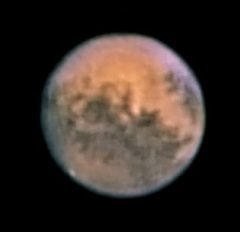
|
This is the best image from the night of 16-17 November 2005, which is a combination of RGB (with UV-IR blocker) and IR luminance images.
The RGB was a stack of 400 out of 1400 frames, and the IR was 500 out of 3120 frames. | ||||||
|
In contrast to other pictures captured that night, when I tried out some shorter exposures and higher gain settings, for these images I used 1/33 exposure for both AVIs and 43% (RGB) and 81% (IR) gain.
Both AVIs were stacked in K3CCDTools, with wavelets applied in Registax. Then I lightly sharpened the IR and layered it on the RGB using The Gimp. Next I did some noise removal using Noiseware Community Edition. That may well have been the important step. It allowed me to go back to The Gimp and sharpen further. In fact I selectively sharpened, so as not to bring back any noise in the red areas of the planet. |
|||||||
| to top | home | ||||||
31 August 2005, The Milky Way

|
This is my best picture yet of our galaxy. The frames were captured in Spain under a very dark sky. The sky, plus the more southerly location meant that I could capture much better images of the centre of our galaxy than at home (compare with those further below). | ||||||
| to top | home | ||||||
23 November 2006: M31, The Andromeda Galaxy, with companions M32 and M110
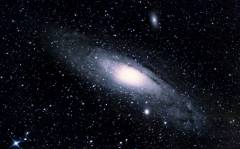
|
This image shows the great Andromeda Galaxy, our nearest galactic neighbour at around 3 million light years away. The small elongated galaxy at the top of the picture is M110, and the smaller fuzzy spot between stars to the lower right of the large galaxy is M32. Both are companions to M31 and are eliptical galaxies (as opposed to M31's spiral shape).
This is a stack of 48 90-second exposures captured with my Canon EOS300D in Raw mode, at prime focus of the Megrez 80SD II refractor. The six images were stacked in Deep Sky Stacker, then I processed the result using Pleiades PixInsight LE and The Gimp. |
||||||
| to top | home | ||||||
10 May 2005: The Virgo galaxy cluster

|
The constellation of Virgo contains a cluster of hundreds of galaxies. I used my Canon DSLR attached to the ST80 wide-field refractor to capture an image showing almost 30 galaxies including the Messier objects M84, M86, M87, and M88.
The line of galaxies crossing the picture approximately from bottom-left to top-right is known as Marakarian's Chain. |
||||||
| to top | home | ||||||
22 March 2005, Sinus Iridum in Red Light
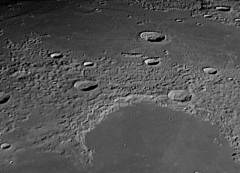
|
Following a tip from the QCUIAG Yahoo Group, I replaced the infra-red blocking filter on my ToUCam Pro with a simple red filter. This allows only the red and infra-red light, which is less susceptible to poor atmospheric seeing, through to the webcam's sensor.
I was very impressed with the results. This is an image of the Sinus Iridum, or the Bay of Rainbows, and an area of the Mare Frigoris to the north. This was imaged with the Europa 250 and a 2x Barlow lens. The camera settings were: 5 fps, Gamma 20, Saturation 0, shutter/gain auto (accidental but it worked!). 250 frames were stacked (out of 512 captured) in Registax 2, 2x resampled in stacking. The post-processing was sharpening, noise reduction, and brightness adjustment in The Gimp 2, and downsampled to 67%. | ||||||
| to top | home | ||||||
22 March 2005, Aristarchus Plateau in Red Light
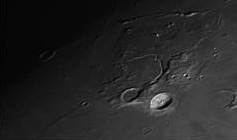
|
Another image in red light, like the one above, this is a detail of the Aristarchus Plateau, showing the crater Aristarchus with the pattern of light and dark on the inner crater wall clearly visible, and Herodotus with Schroter's Valley and other rilles around. Compare with the image from 25 October 2004 below.
This was imaged with the Europa 250 and a 2x Barlow lens. The camera settings were: 5 fps, Gamma 20, Saturation 0, shutter/gain auto (accidental but it worked!). 250 frames were stacked (out of 512 captured) in Registax 2, 2x resampled in stacking. The post-processing was sharpening, noise reduction, and brightness adjustment in The Gimp 2, and downsampled to 67%. | ||||||
| to top | home | ||||||
18 December 2004: M1, The Crab Nebula
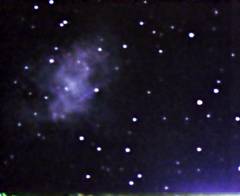
|
The first object in Messier's list, M1 (also known as the Crab Nebula), is the remnant of a star that exploded in a supernova almost 1000 years ago.
This picture was captured at prime focus of my Europa 250 telescope, using the QC3000 camera. I stacked 35 frames of 25 seconds each, using Registax 2. The picture was processed in the Gimp as usual. |
||||||
| to top | home | ||||||
14 November 2004: NGC 891
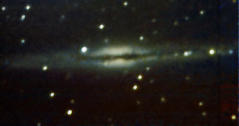
|
NGC 891 is an edge-on spiral galaxy in the constellation of Andromeda. It has a promenant dust lane visible along its edge. Like most galaxies, this is a faint object and clear details are difficult with an SC1 webcam.
This image was formed by combining three stacks, of 100x45 seconds, 32x40 seconds and finally 3x60 seconds in The Gimp. Each was captured at prime focus with the QC3000 SC1.5. The brighter stars were reduced a little using the "dilate" filter in The Gimp. | ||||||
4 October 2004: Nebulosity around Alpha and Gamma Cygnu
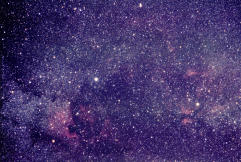
|
Around the brightest stars of the constellation of Cygnus are many areas of glowing hydrogen gas. The largest and brightest are near Alpha (Deneb) and Gamma (Sadr) and includ the North America Nebula (NGC 7000) and the Pelican Nebula (NGC 5067).
This was a photo captured on film (135mm lens at f/4.0 exposed for 15 minutes), then processed, scanned and post-processed in the Gimp. Click the picture for a large image, or HERE for a mid-sized one with the objects labelled. | ||||||
6 September, 2004: The Great Cluster in Hercules
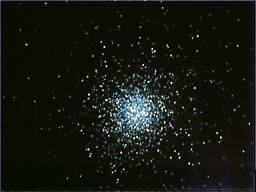
|
Messier object 13 is also known as the Great Cluster in Hercules. It is one of the best examples of a Globular Cluster, many of which are scattered around the outskirts of our galaxy, each containing millions of stars. This picture was captured using the long-exposure capabilities of the modified QuickCam 3000. It also took advantage of RAW mode, which was then debayered (converted to normal colour) in AVIRaw. iPrep was used to remove hot pixels and the image was processed in the Gimp and NeatImage. 120 frames of 10 seconds each were stacked. | ||||||
| to top | home | ||||||
8 June 2004: Transit of Venus
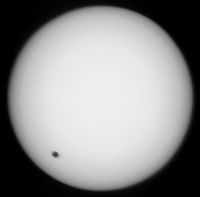
|
On 8 June 2004, Venus was in inferior conjunction with the Earth -- this means it was exactly between the Earth and the sun. What's more, we were at a point when the planes of the orbits of Venus and Earth cross. The result is that Venus appeared to cross the sun as seen from the Earth. This is called a transit. Transits of Venus normally happen in pairs spaced 8 years apart. 130 years pass between pairs of transits -- the last transit was 122 years before, and the next one will be in 2012.
This image is an overlapping mosaic of several stacked images spaced over about 5 minutes. They were captured using a 300mm SLR lens attached to my QuickCam 3000 camera piggy-backed on the telescope on the Vixen SP mount. The lens was fitted with a filter made from Baader solar film. |
||||||
| to top | home | ||||||
17 June 2005, 10-day moon mosaic
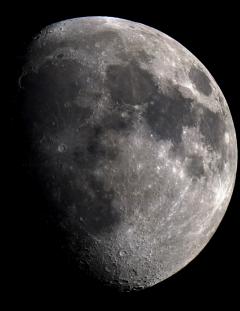
|
Here is a mosaic of the 10-day moon. Despite the very low altitude of the moon at this time of the year the seeing was good enough to result in a very good image. I merged 18 pieces using iMerge. Each was 140 frames chosen from 300 I captured using my Toucam pro with a 2x barlow and Baader UV-IR filter, on the Europa 250.
Each piece of the mosaic was stacked in Registax and light wavelets applied, then into iMerge to create the mosaic. No further processing was required. Click the image to see a larger picture, or click HERE to see the full-sized image. |
||||||
| to top | home | ||||||
10 May 2005, 2-day, 9 hours waxing crescent
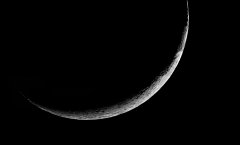
|
Here the moon is shown when it is 2 days and 9 hours after new moon, approximately the same age as the Earthshine picture from 10 March below. At this age only a few features of the moon can be seen well, and the contrast is low because of the still-bright sky at the time the picture was taken.
This picture is a mosaic constructed from 6 individual images. Each of them is a stack of 150 frames (selected from 300). They were captured using the ToUCam Pro at prime focus of the Europa 250 using a red filter to enhance contrast. Frames were stacked in Registax 3 then merged in iMerge. The resulting mosaic was sharpened in Registax and The Gimp. Because the sky was still getting darker at the time the pictures were captured, the pieces of the mosaic didn't match each other in brightness. It was necessary to adjust the brightness of the stacked images using the Levels tool in The Gimp before assembling the final mosaic. |
||||||
| to top | home | ||||||
25 March 2005, Full Moon
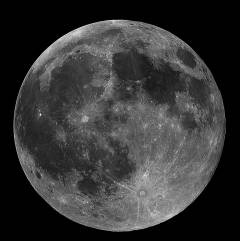
|
This picture shows the full moon captured as a mosaic of 30 pieces. Each was a stack of the best 40 frames chosen automatically from 145. The frames were captured at prime focus of the Europa 250 f/4.8 Newtonian, with the ToUCam Pro. I used Baader UV-IR blocker and contrast booster filters to help with the quality of the image.
Each AVI was aligned and stacked in Registax 3. No resampling was used because I found it to cause grid or horizontal line artifacts, depending on the resampling algorithm used. The stacked images were composed into the full moon mosaic in iMerge, then the whole image was saved and imported into Registax again for wavelet sharpening. Only light wavelets were applied, then The Gimp was used for small colour adjustments and unsharp mask applied. Click the image for a full-screen image, or here for the full sized image (as captured). |
||||||
| to top | home | ||||||
30 March 2004: Crater Plato and the Lunar Alps
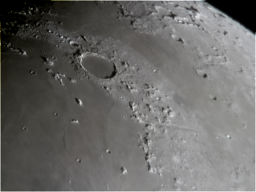
|
Here can be seen the Montes Alpes (Lunar Alps) including the Alpine Valley, and the crater Plato. Although the Alpine valley can be seen clearly, the rille running down the middle of it is beyond the capabilities of the small telescope used (114mm/f8 reflector with 2x Barlow). Beyond the Alps, in the top-right of the picture, the large W. Bond crater can be seen. This image was created from around 300 frames stacked in Registax 2, then wavelet enhancement applied. | ||||||
| to top | home | ||||||
2 April 2004: Crater Tycho and Mare Nubium
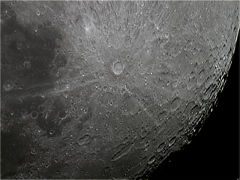
|
This is Tycho, the crater that displays the greatest ray structure on the moon, around it. A pair of rays goes off to the left of the picture into the dark area which is the Mare Nubium (Sea of Clouds). The black crater above the pair of rays, almost part of the Mare Nubium is Pitatus. To the right of Tycho in the picture is Clavius, with it's distinctive chain of five progressively smaller craters inside the large one. More details of Clavius can be seen on the moon page (picture from 30 March 2004). | ||||||
| to top | home | ||||||
29 March 2004: Mountains around Mare Imbrium

|
An interesting mosaic (due to the number of features included) showing the mountains around the north and eastern edge of the Mare Imbrium (clockwise from top, Montes Alpes, Montes Caucasus, Montes Apenninus) and the crater Archimedes (including Montes Archimedes), when the shadow terminator was close. Compare this picture with the image of Plato and the Alps from one day later on 30 March 2004. This image is a mosaic of 6 separate ones, each of which was formed from around 300 AVI frames stacked and aligned in Registax 2, then merged with iMerge. | ||||||
| to top | home | ||||||
8 April, 2005 - Great Red Spot transit

|
On the night of 8 April 2005, I knew that Jupiter's great red spot would be crossing the planet (known as transiting) at a favourable time for me for imaging. I captured 21 AVIs using the 2x Barlow and all with the same settings. This was ideal for creating an animation, which is shown here. Each of the 21 frames of the animation was created from a stack of 675 frames out of 1350 captured with the ToUCam pro. I used K3CCDTools to automatically capture for 90 seconds every 4 minutes, which gave just enough interval between each to see some movement on the final animation, whilst not ending up with too many images to process. Each AVI was stacked in K3CCDTools, wavelets applied in Registax 3, sharpening and resizing in The Gimp. The frames were aligned using K3CCDTools again, and finally the animation was put together in The Gimp. Click the image to see the best frame from the animation | ||||||
| to top | home | ||||||
18 March 2004: Jupiter with GRS

|
My best Jupiter picture, this shows the great red spot nicely, and some nice detail. I stacked 400 frames in K3CCDTools, applied wavelets in Registax 2, then adjusted colour and applied unsharp mask in The Gimp, as always. The camera was attached to the 2x Barlow lens on the 114mm f8 Newtonian reflector, and the settings were: Brightness mid, saturation max, gamma was 0, gain 50%, and shutter speed was 1/50s. | ||||||
| to top | home | ||||||
Saturn, 22 January 2006
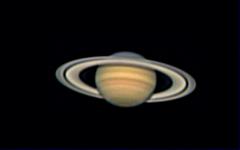
|
I had great luck with Saturn on this night. I centred the planet in the eyepiece of my my Europa 250, put in my 5x Powermate and centred it again. I was surprised when I put the ToUCam in and found it was perfectly focussed! One of my eyepieces must be parfocal with the camera, I must do some experiments to find out which.
Perhaps it was the 3-hour cooling down, perhaps it was the laser collimation (although that's not unusual), perhaps just seeing and a bit of luck. Whatever, I had the best preview image I can ever remember, with the Cassini division clearly visible all the time -- which is unusual for me. Mindful of software-imposed limits, I captured lots of 1800-frame AVIs, and stacked the best 100 from each. This first result is 600 from 10,800 frames at 15fps. | ||||||
|
You can see that in this image the shadow of the planet on its rings is very small, and almost equal on both sides (although it is clearly slightly bigger on the right). This is because this image was taken close to opposition, when Saturn is directly opposite the sun in Earth's sky.
Details:
| |||||||
| to top | home | ||||||
Venus, 30 March 2004

|
At this time of year, Venus is an "evening star" following the sun. Here the crescent phase of Venus is becoming clearer and over the next few weeks it should become more and more noticable. | ||||||
| to top | home | ||||||

|
|||||||
 |
|||||||
| All images copyright and may not be used without permission |
|||||||